Comprehensive Analysis: Water Quality and Wastewater Treatment
VerifiedAdded on 2022/10/12
|10
|2617
|179
Report
AI Summary
This report delves into the critical issue of water quality, exploring the impact of contaminants from various sources, including industrial, household, and agricultural activities. It examines the importance of wastewater treatment processes in mitigating waterborne illnesses and chemical contamination. The report provides data on water quality assessments, highlighting the prevalence of pollutants and the challenges in providing safe drinking water. It discusses various wastewater treatment methods, the impact of contaminated water on human health, including the chain through which chemicals reach the body, and the steps involved in water purification. The report emphasizes the importance of the Safe Drinking Water Act and the need for continuous efforts to improve water quality and protect public health, referencing key statistics, and providing a comprehensive overview of the issues and solutions related to water quality and environmental health.
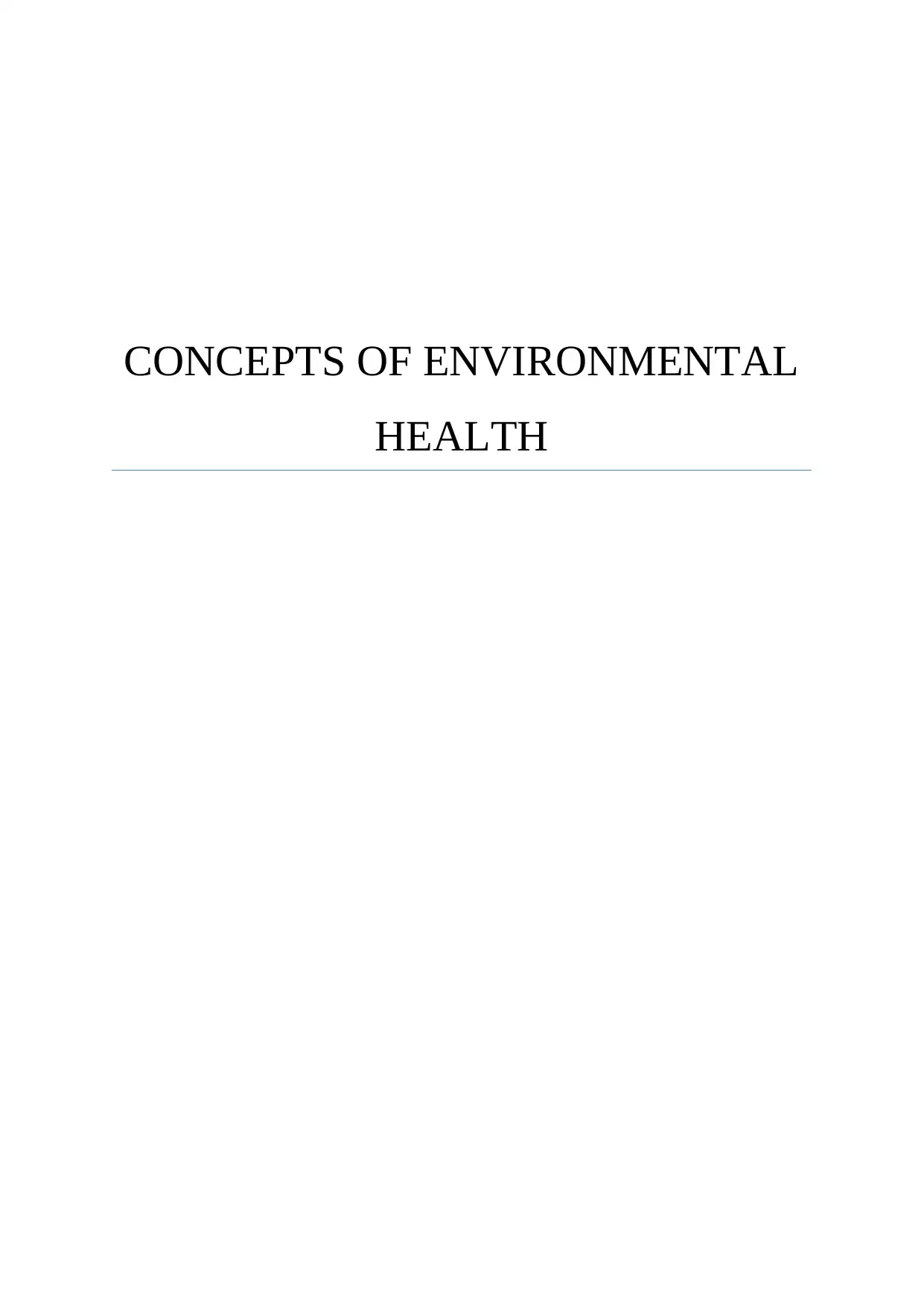
CONCEPTS OF ENVIRONMENTAL
HEALTH
HEALTH
Paraphrase This Document
Need a fresh take? Get an instant paraphrase of this document with our AI Paraphraser

1
Contents
Introduction...........................................................................................................................................1
Water quality.........................................................................................................................................1
Waste water treatment...........................................................................................................................2
Impact analysis of the contaminated water............................................................................................4
Chain through which chemical reaches to body.....................................................................................5
Treatment process of the contaminated water........................................................................................6
Conclusion.............................................................................................................................................6
References.............................................................................................................................................6
Contents
Introduction...........................................................................................................................................1
Water quality.........................................................................................................................................1
Waste water treatment...........................................................................................................................2
Impact analysis of the contaminated water............................................................................................4
Chain through which chemical reaches to body.....................................................................................5
Treatment process of the contaminated water........................................................................................6
Conclusion.............................................................................................................................................6
References.............................................................................................................................................6
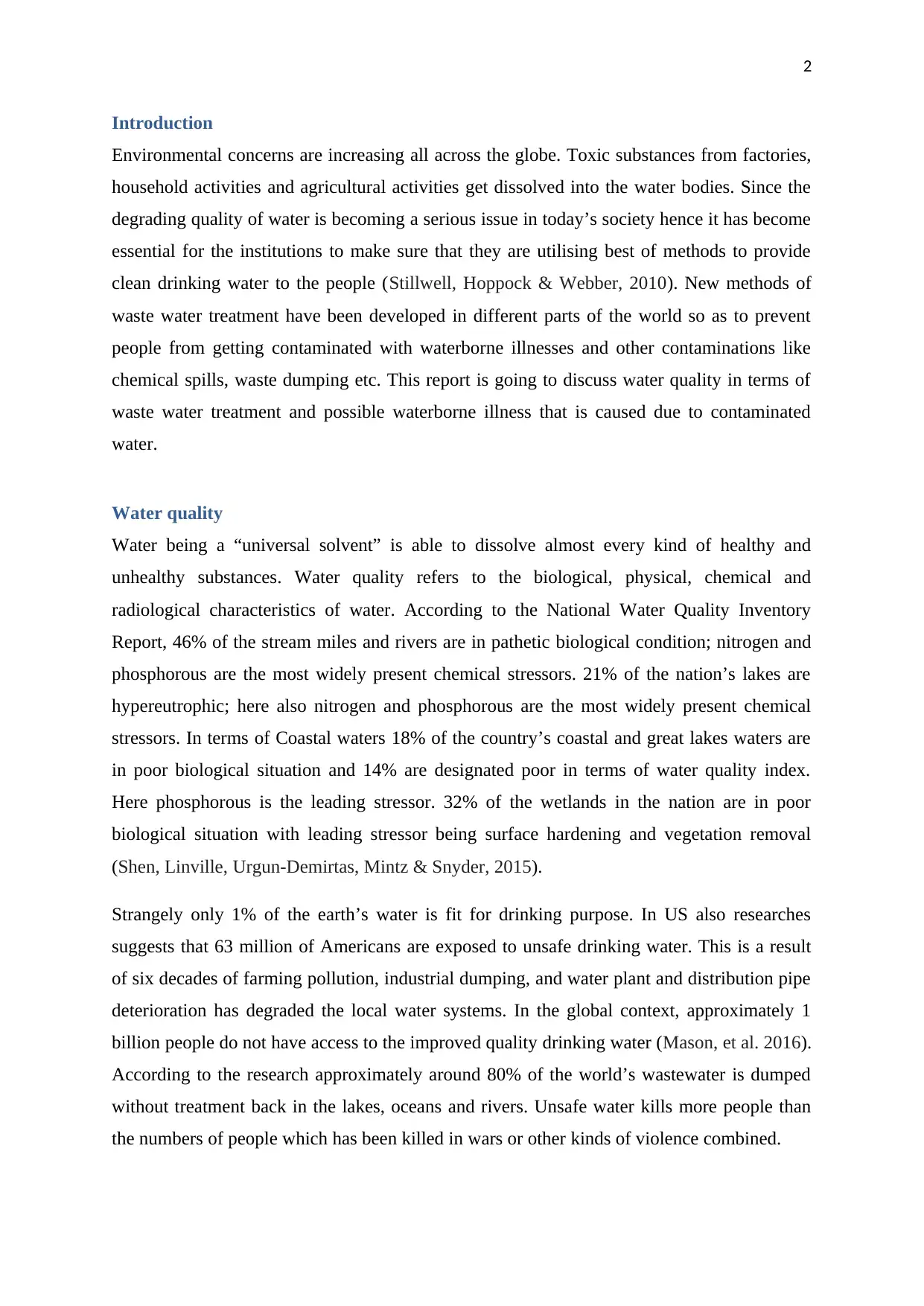
2
Introduction
Environmental concerns are increasing all across the globe. Toxic substances from factories,
household activities and agricultural activities get dissolved into the water bodies. Since the
degrading quality of water is becoming a serious issue in today’s society hence it has become
essential for the institutions to make sure that they are utilising best of methods to provide
clean drinking water to the people (Stillwell, Hoppock & Webber, 2010). New methods of
waste water treatment have been developed in different parts of the world so as to prevent
people from getting contaminated with waterborne illnesses and other contaminations like
chemical spills, waste dumping etc. This report is going to discuss water quality in terms of
waste water treatment and possible waterborne illness that is caused due to contaminated
water.
Water quality
Water being a “universal solvent” is able to dissolve almost every kind of healthy and
unhealthy substances. Water quality refers to the biological, physical, chemical and
radiological characteristics of water. According to the National Water Quality Inventory
Report, 46% of the stream miles and rivers are in pathetic biological condition; nitrogen and
phosphorous are the most widely present chemical stressors. 21% of the nation’s lakes are
hypereutrophic; here also nitrogen and phosphorous are the most widely present chemical
stressors. In terms of Coastal waters 18% of the country’s coastal and great lakes waters are
in poor biological situation and 14% are designated poor in terms of water quality index.
Here phosphorous is the leading stressor. 32% of the wetlands in the nation are in poor
biological situation with leading stressor being surface hardening and vegetation removal
(Shen, Linville, Urgun-Demirtas, Mintz & Snyder, 2015).
Strangely only 1% of the earth’s water is fit for drinking purpose. In US also researches
suggests that 63 million of Americans are exposed to unsafe drinking water. This is a result
of six decades of farming pollution, industrial dumping, and water plant and distribution pipe
deterioration has degraded the local water systems. In the global context, approximately 1
billion people do not have access to the improved quality drinking water (Mason, et al. 2016).
According to the research approximately around 80% of the world’s wastewater is dumped
without treatment back in the lakes, oceans and rivers. Unsafe water kills more people than
the numbers of people which has been killed in wars or other kinds of violence combined.
Introduction
Environmental concerns are increasing all across the globe. Toxic substances from factories,
household activities and agricultural activities get dissolved into the water bodies. Since the
degrading quality of water is becoming a serious issue in today’s society hence it has become
essential for the institutions to make sure that they are utilising best of methods to provide
clean drinking water to the people (Stillwell, Hoppock & Webber, 2010). New methods of
waste water treatment have been developed in different parts of the world so as to prevent
people from getting contaminated with waterborne illnesses and other contaminations like
chemical spills, waste dumping etc. This report is going to discuss water quality in terms of
waste water treatment and possible waterborne illness that is caused due to contaminated
water.
Water quality
Water being a “universal solvent” is able to dissolve almost every kind of healthy and
unhealthy substances. Water quality refers to the biological, physical, chemical and
radiological characteristics of water. According to the National Water Quality Inventory
Report, 46% of the stream miles and rivers are in pathetic biological condition; nitrogen and
phosphorous are the most widely present chemical stressors. 21% of the nation’s lakes are
hypereutrophic; here also nitrogen and phosphorous are the most widely present chemical
stressors. In terms of Coastal waters 18% of the country’s coastal and great lakes waters are
in poor biological situation and 14% are designated poor in terms of water quality index.
Here phosphorous is the leading stressor. 32% of the wetlands in the nation are in poor
biological situation with leading stressor being surface hardening and vegetation removal
(Shen, Linville, Urgun-Demirtas, Mintz & Snyder, 2015).
Strangely only 1% of the earth’s water is fit for drinking purpose. In US also researches
suggests that 63 million of Americans are exposed to unsafe drinking water. This is a result
of six decades of farming pollution, industrial dumping, and water plant and distribution pipe
deterioration has degraded the local water systems. In the global context, approximately 1
billion people do not have access to the improved quality drinking water (Mason, et al. 2016).
According to the research approximately around 80% of the world’s wastewater is dumped
without treatment back in the lakes, oceans and rivers. Unsafe water kills more people than
the numbers of people which has been killed in wars or other kinds of violence combined.
⊘ This is a preview!⊘
Do you want full access?
Subscribe today to unlock all pages.

Trusted by 1+ million students worldwide
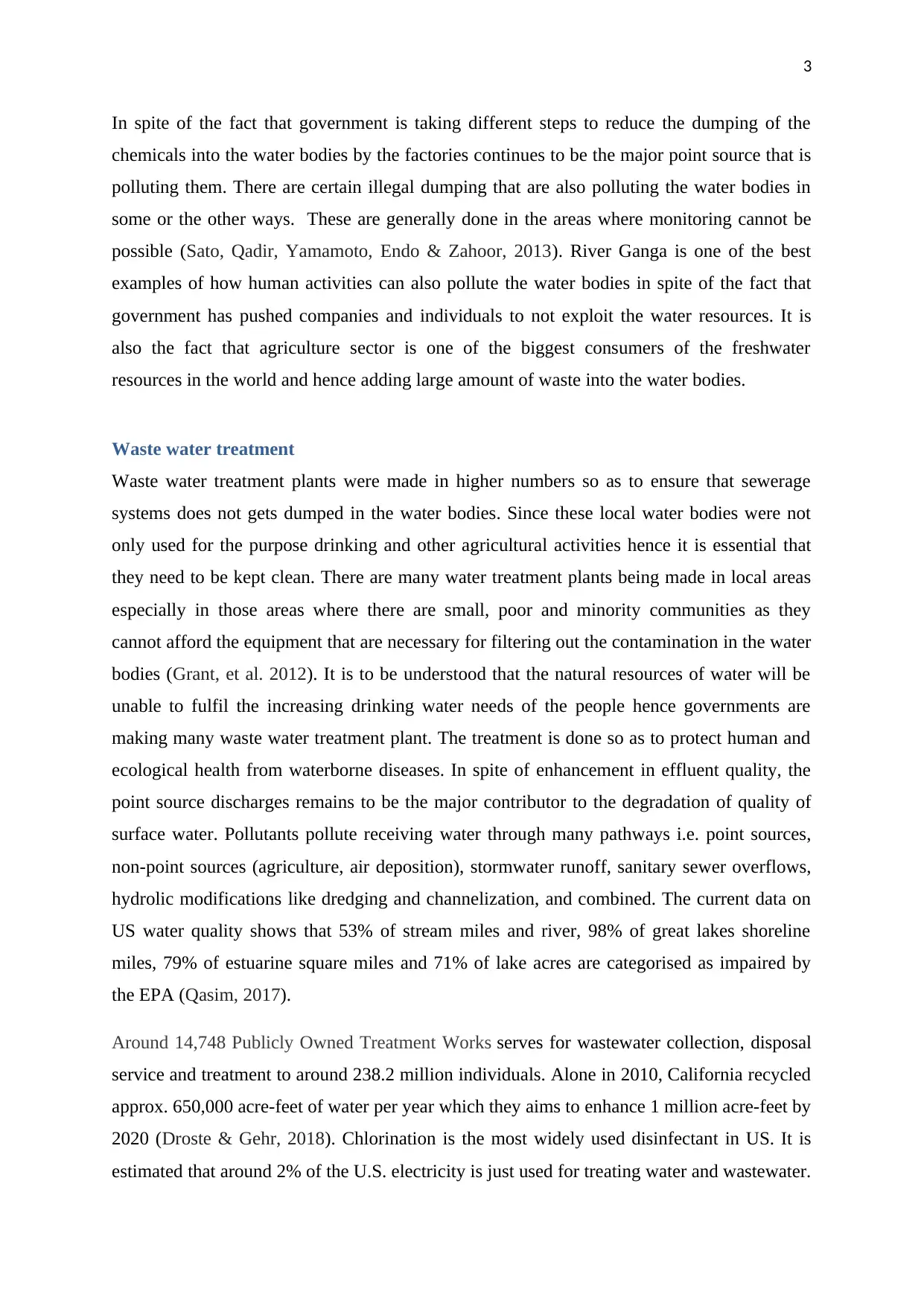
3
In spite of the fact that government is taking different steps to reduce the dumping of the
chemicals into the water bodies by the factories continues to be the major point source that is
polluting them. There are certain illegal dumping that are also polluting the water bodies in
some or the other ways. These are generally done in the areas where monitoring cannot be
possible (Sato, Qadir, Yamamoto, Endo & Zahoor, 2013). River Ganga is one of the best
examples of how human activities can also pollute the water bodies in spite of the fact that
government has pushed companies and individuals to not exploit the water resources. It is
also the fact that agriculture sector is one of the biggest consumers of the freshwater
resources in the world and hence adding large amount of waste into the water bodies.
Waste water treatment
Waste water treatment plants were made in higher numbers so as to ensure that sewerage
systems does not gets dumped in the water bodies. Since these local water bodies were not
only used for the purpose drinking and other agricultural activities hence it is essential that
they need to be kept clean. There are many water treatment plants being made in local areas
especially in those areas where there are small, poor and minority communities as they
cannot afford the equipment that are necessary for filtering out the contamination in the water
bodies (Grant, et al. 2012). It is to be understood that the natural resources of water will be
unable to fulfil the increasing drinking water needs of the people hence governments are
making many waste water treatment plant. The treatment is done so as to protect human and
ecological health from waterborne diseases. In spite of enhancement in effluent quality, the
point source discharges remains to be the major contributor to the degradation of quality of
surface water. Pollutants pollute receiving water through many pathways i.e. point sources,
non-point sources (agriculture, air deposition), stormwater runoff, sanitary sewer overflows,
hydrolic modifications like dredging and channelization, and combined. The current data on
US water quality shows that 53% of stream miles and river, 98% of great lakes shoreline
miles, 79% of estuarine square miles and 71% of lake acres are categorised as impaired by
the EPA (Qasim, 2017).
Around 14,748 Publicly Owned Treatment Works serves for wastewater collection, disposal
service and treatment to around 238.2 million individuals. Alone in 2010, California recycled
approx. 650,000 acre-feet of water per year which they aims to enhance 1 million acre-feet by
2020 (Droste & Gehr, 2018). Chlorination is the most widely used disinfectant in US. It is
estimated that around 2% of the U.S. electricity is just used for treating water and wastewater.
In spite of the fact that government is taking different steps to reduce the dumping of the
chemicals into the water bodies by the factories continues to be the major point source that is
polluting them. There are certain illegal dumping that are also polluting the water bodies in
some or the other ways. These are generally done in the areas where monitoring cannot be
possible (Sato, Qadir, Yamamoto, Endo & Zahoor, 2013). River Ganga is one of the best
examples of how human activities can also pollute the water bodies in spite of the fact that
government has pushed companies and individuals to not exploit the water resources. It is
also the fact that agriculture sector is one of the biggest consumers of the freshwater
resources in the world and hence adding large amount of waste into the water bodies.
Waste water treatment
Waste water treatment plants were made in higher numbers so as to ensure that sewerage
systems does not gets dumped in the water bodies. Since these local water bodies were not
only used for the purpose drinking and other agricultural activities hence it is essential that
they need to be kept clean. There are many water treatment plants being made in local areas
especially in those areas where there are small, poor and minority communities as they
cannot afford the equipment that are necessary for filtering out the contamination in the water
bodies (Grant, et al. 2012). It is to be understood that the natural resources of water will be
unable to fulfil the increasing drinking water needs of the people hence governments are
making many waste water treatment plant. The treatment is done so as to protect human and
ecological health from waterborne diseases. In spite of enhancement in effluent quality, the
point source discharges remains to be the major contributor to the degradation of quality of
surface water. Pollutants pollute receiving water through many pathways i.e. point sources,
non-point sources (agriculture, air deposition), stormwater runoff, sanitary sewer overflows,
hydrolic modifications like dredging and channelization, and combined. The current data on
US water quality shows that 53% of stream miles and river, 98% of great lakes shoreline
miles, 79% of estuarine square miles and 71% of lake acres are categorised as impaired by
the EPA (Qasim, 2017).
Around 14,748 Publicly Owned Treatment Works serves for wastewater collection, disposal
service and treatment to around 238.2 million individuals. Alone in 2010, California recycled
approx. 650,000 acre-feet of water per year which they aims to enhance 1 million acre-feet by
2020 (Droste & Gehr, 2018). Chlorination is the most widely used disinfectant in US. It is
estimated that around 2% of the U.S. electricity is just used for treating water and wastewater.
Paraphrase This Document
Need a fresh take? Get an instant paraphrase of this document with our AI Paraphraser
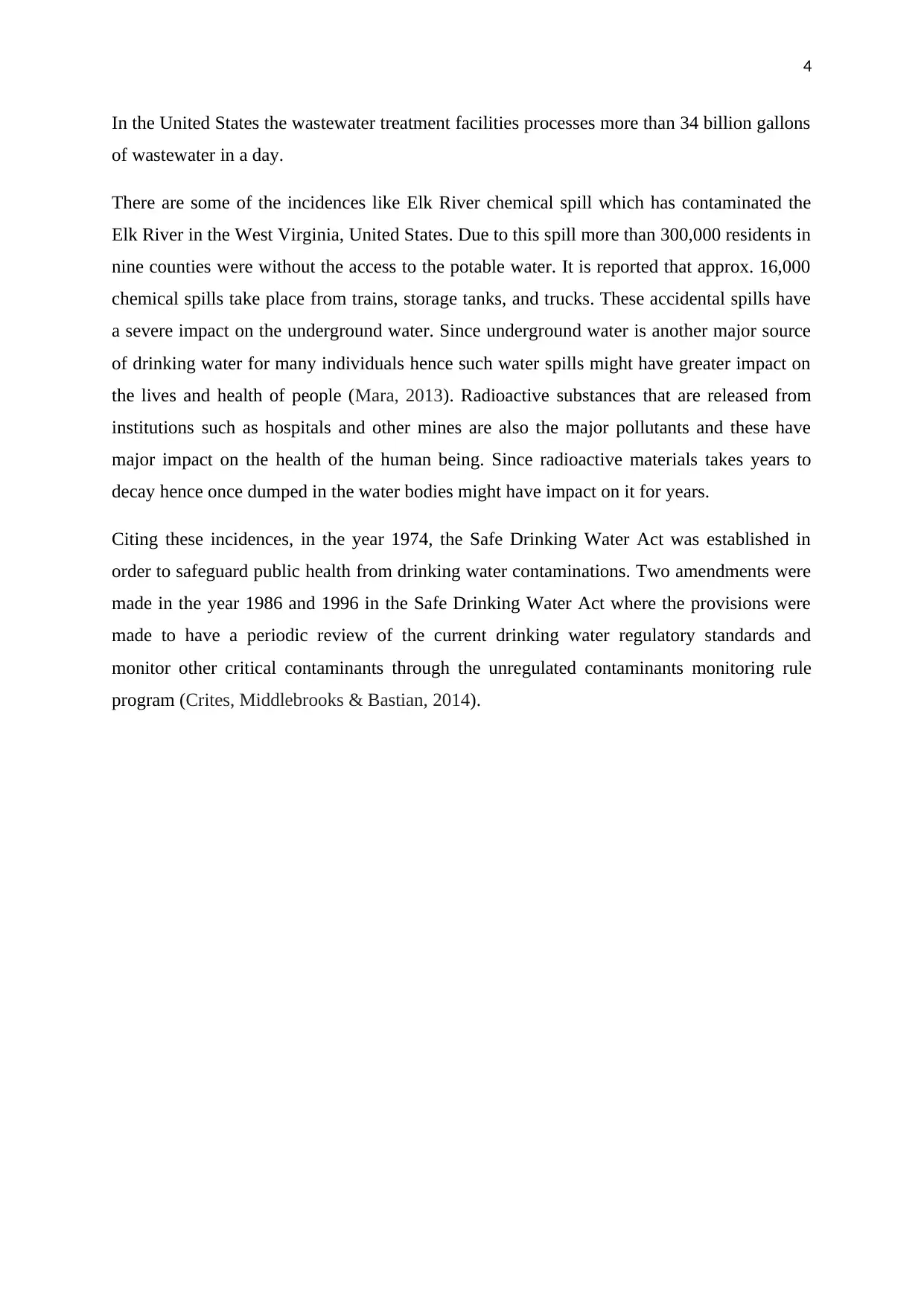
4
In the United States the wastewater treatment facilities processes more than 34 billion gallons
of wastewater in a day.
There are some of the incidences like Elk River chemical spill which has contaminated the
Elk River in the West Virginia, United States. Due to this spill more than 300,000 residents in
nine counties were without the access to the potable water. It is reported that approx. 16,000
chemical spills take place from trains, storage tanks, and trucks. These accidental spills have
a severe impact on the underground water. Since underground water is another major source
of drinking water for many individuals hence such water spills might have greater impact on
the lives and health of people (Mara, 2013). Radioactive substances that are released from
institutions such as hospitals and other mines are also the major pollutants and these have
major impact on the health of the human being. Since radioactive materials takes years to
decay hence once dumped in the water bodies might have impact on it for years.
Citing these incidences, in the year 1974, the Safe Drinking Water Act was established in
order to safeguard public health from drinking water contaminations. Two amendments were
made in the year 1986 and 1996 in the Safe Drinking Water Act where the provisions were
made to have a periodic review of the current drinking water regulatory standards and
monitor other critical contaminants through the unregulated contaminants monitoring rule
program (Crites, Middlebrooks & Bastian, 2014).
In the United States the wastewater treatment facilities processes more than 34 billion gallons
of wastewater in a day.
There are some of the incidences like Elk River chemical spill which has contaminated the
Elk River in the West Virginia, United States. Due to this spill more than 300,000 residents in
nine counties were without the access to the potable water. It is reported that approx. 16,000
chemical spills take place from trains, storage tanks, and trucks. These accidental spills have
a severe impact on the underground water. Since underground water is another major source
of drinking water for many individuals hence such water spills might have greater impact on
the lives and health of people (Mara, 2013). Radioactive substances that are released from
institutions such as hospitals and other mines are also the major pollutants and these have
major impact on the health of the human being. Since radioactive materials takes years to
decay hence once dumped in the water bodies might have impact on it for years.
Citing these incidences, in the year 1974, the Safe Drinking Water Act was established in
order to safeguard public health from drinking water contaminations. Two amendments were
made in the year 1986 and 1996 in the Safe Drinking Water Act where the provisions were
made to have a periodic review of the current drinking water regulatory standards and
monitor other critical contaminants through the unregulated contaminants monitoring rule
program (Crites, Middlebrooks & Bastian, 2014).
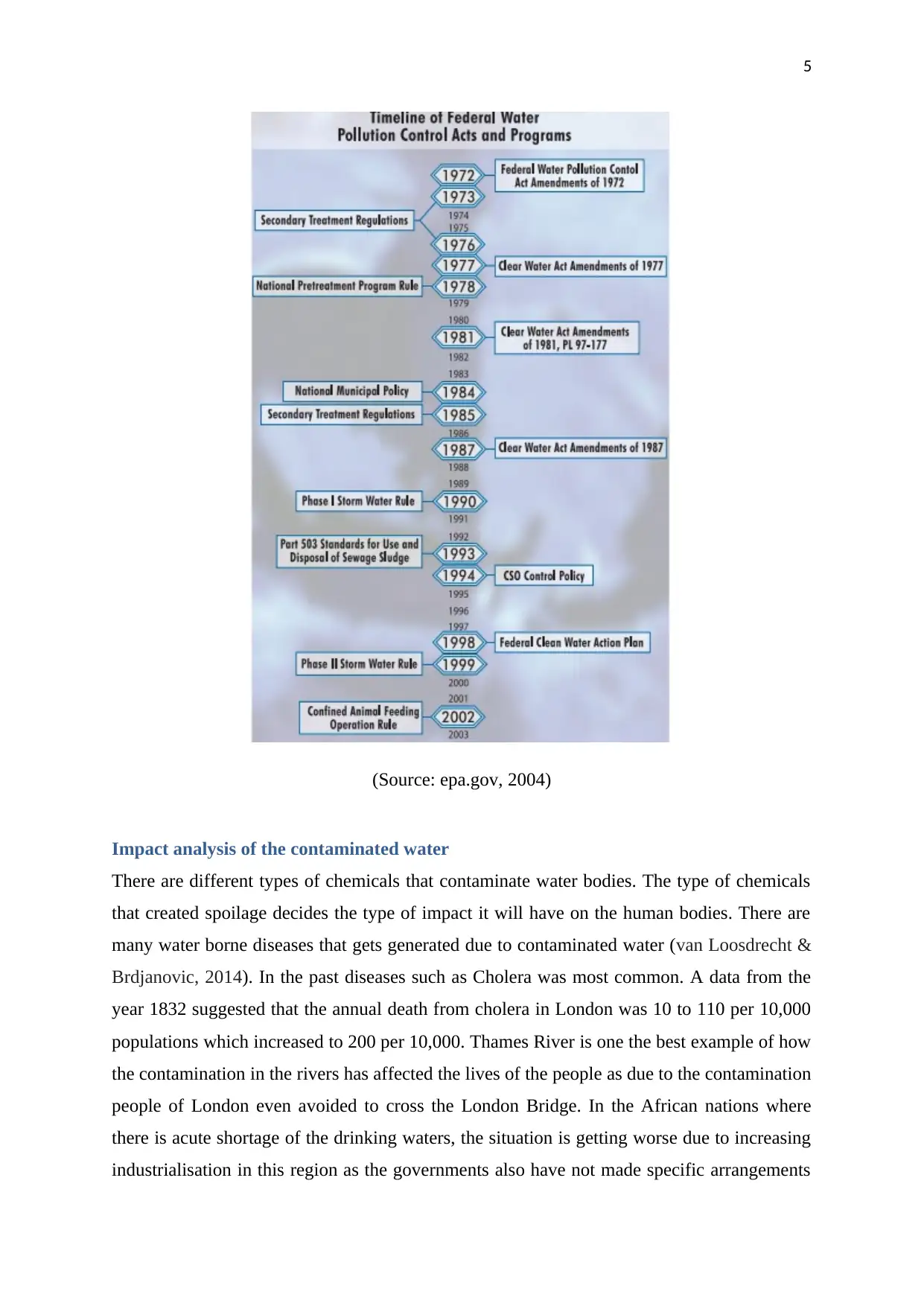
5
(Source: epa.gov, 2004)
Impact analysis of the contaminated water
There are different types of chemicals that contaminate water bodies. The type of chemicals
that created spoilage decides the type of impact it will have on the human bodies. There are
many water borne diseases that gets generated due to contaminated water (van Loosdrecht &
Brdjanovic, 2014). In the past diseases such as Cholera was most common. A data from the
year 1832 suggested that the annual death from cholera in London was 10 to 110 per 10,000
populations which increased to 200 per 10,000. Thames River is one the best example of how
the contamination in the rivers has affected the lives of the people as due to the contamination
people of London even avoided to cross the London Bridge. In the African nations where
there is acute shortage of the drinking waters, the situation is getting worse due to increasing
industrialisation in this region as the governments also have not made specific arrangements
(Source: epa.gov, 2004)
Impact analysis of the contaminated water
There are different types of chemicals that contaminate water bodies. The type of chemicals
that created spoilage decides the type of impact it will have on the human bodies. There are
many water borne diseases that gets generated due to contaminated water (van Loosdrecht &
Brdjanovic, 2014). In the past diseases such as Cholera was most common. A data from the
year 1832 suggested that the annual death from cholera in London was 10 to 110 per 10,000
populations which increased to 200 per 10,000. Thames River is one the best example of how
the contamination in the rivers has affected the lives of the people as due to the contamination
people of London even avoided to cross the London Bridge. In the African nations where
there is acute shortage of the drinking waters, the situation is getting worse due to increasing
industrialisation in this region as the governments also have not made specific arrangements
⊘ This is a preview!⊘
Do you want full access?
Subscribe today to unlock all pages.

Trusted by 1+ million students worldwide
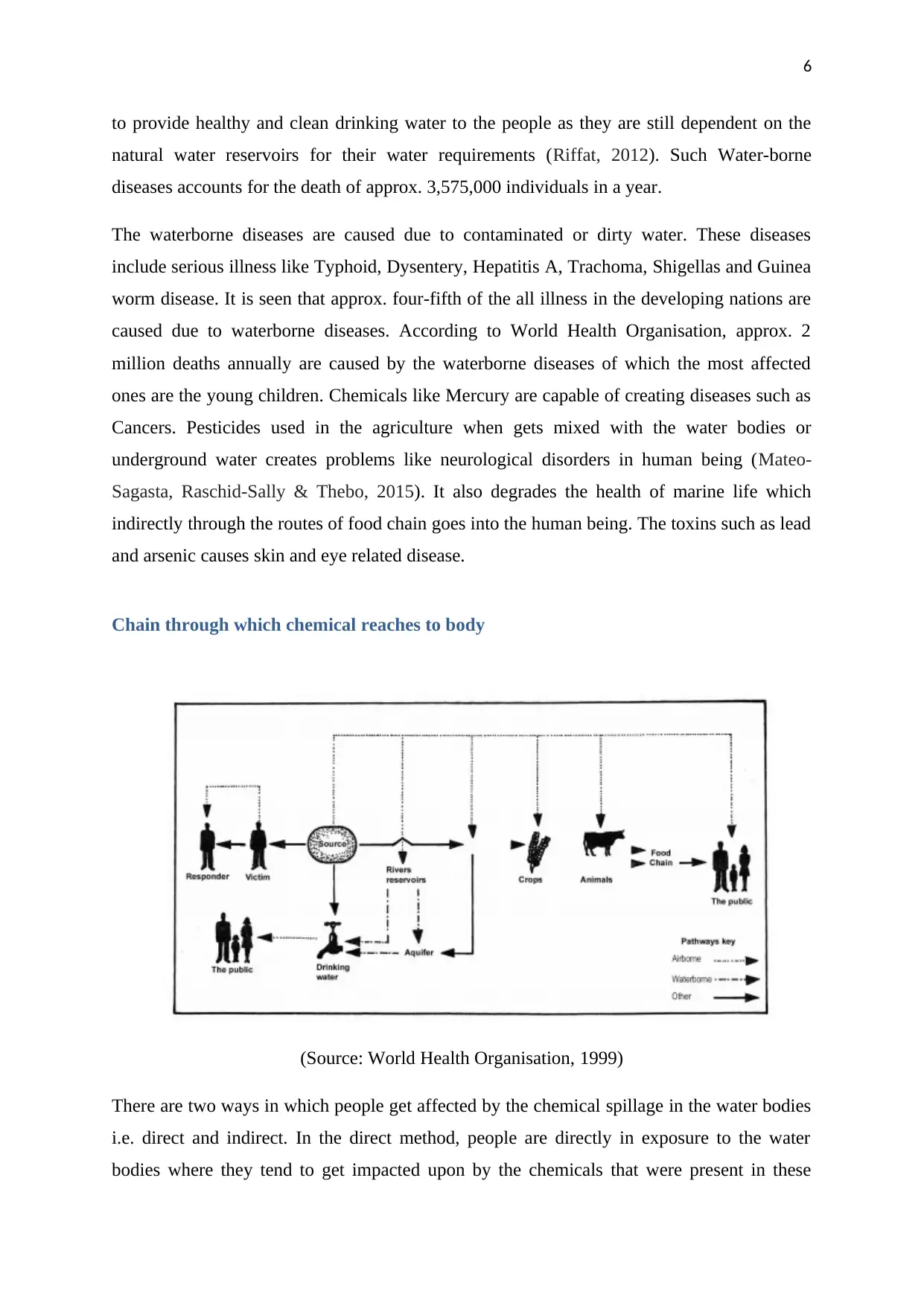
6
to provide healthy and clean drinking water to the people as they are still dependent on the
natural water reservoirs for their water requirements (Riffat, 2012). Such Water-borne
diseases accounts for the death of approx. 3,575,000 individuals in a year.
The waterborne diseases are caused due to contaminated or dirty water. These diseases
include serious illness like Typhoid, Dysentery, Hepatitis A, Trachoma, Shigellas and Guinea
worm disease. It is seen that approx. four-fifth of the all illness in the developing nations are
caused due to waterborne diseases. According to World Health Organisation, approx. 2
million deaths annually are caused by the waterborne diseases of which the most affected
ones are the young children. Chemicals like Mercury are capable of creating diseases such as
Cancers. Pesticides used in the agriculture when gets mixed with the water bodies or
underground water creates problems like neurological disorders in human being (Mateo-
Sagasta, Raschid-Sally & Thebo, 2015). It also degrades the health of marine life which
indirectly through the routes of food chain goes into the human being. The toxins such as lead
and arsenic causes skin and eye related disease.
Chain through which chemical reaches to body
(Source: World Health Organisation, 1999)
There are two ways in which people get affected by the chemical spillage in the water bodies
i.e. direct and indirect. In the direct method, people are directly in exposure to the water
bodies where they tend to get impacted upon by the chemicals that were present in these
to provide healthy and clean drinking water to the people as they are still dependent on the
natural water reservoirs for their water requirements (Riffat, 2012). Such Water-borne
diseases accounts for the death of approx. 3,575,000 individuals in a year.
The waterborne diseases are caused due to contaminated or dirty water. These diseases
include serious illness like Typhoid, Dysentery, Hepatitis A, Trachoma, Shigellas and Guinea
worm disease. It is seen that approx. four-fifth of the all illness in the developing nations are
caused due to waterborne diseases. According to World Health Organisation, approx. 2
million deaths annually are caused by the waterborne diseases of which the most affected
ones are the young children. Chemicals like Mercury are capable of creating diseases such as
Cancers. Pesticides used in the agriculture when gets mixed with the water bodies or
underground water creates problems like neurological disorders in human being (Mateo-
Sagasta, Raschid-Sally & Thebo, 2015). It also degrades the health of marine life which
indirectly through the routes of food chain goes into the human being. The toxins such as lead
and arsenic causes skin and eye related disease.
Chain through which chemical reaches to body
(Source: World Health Organisation, 1999)
There are two ways in which people get affected by the chemical spillage in the water bodies
i.e. direct and indirect. In the direct method, people are directly in exposure to the water
bodies where they tend to get impacted upon by the chemicals that were present in these
Paraphrase This Document
Need a fresh take? Get an instant paraphrase of this document with our AI Paraphraser
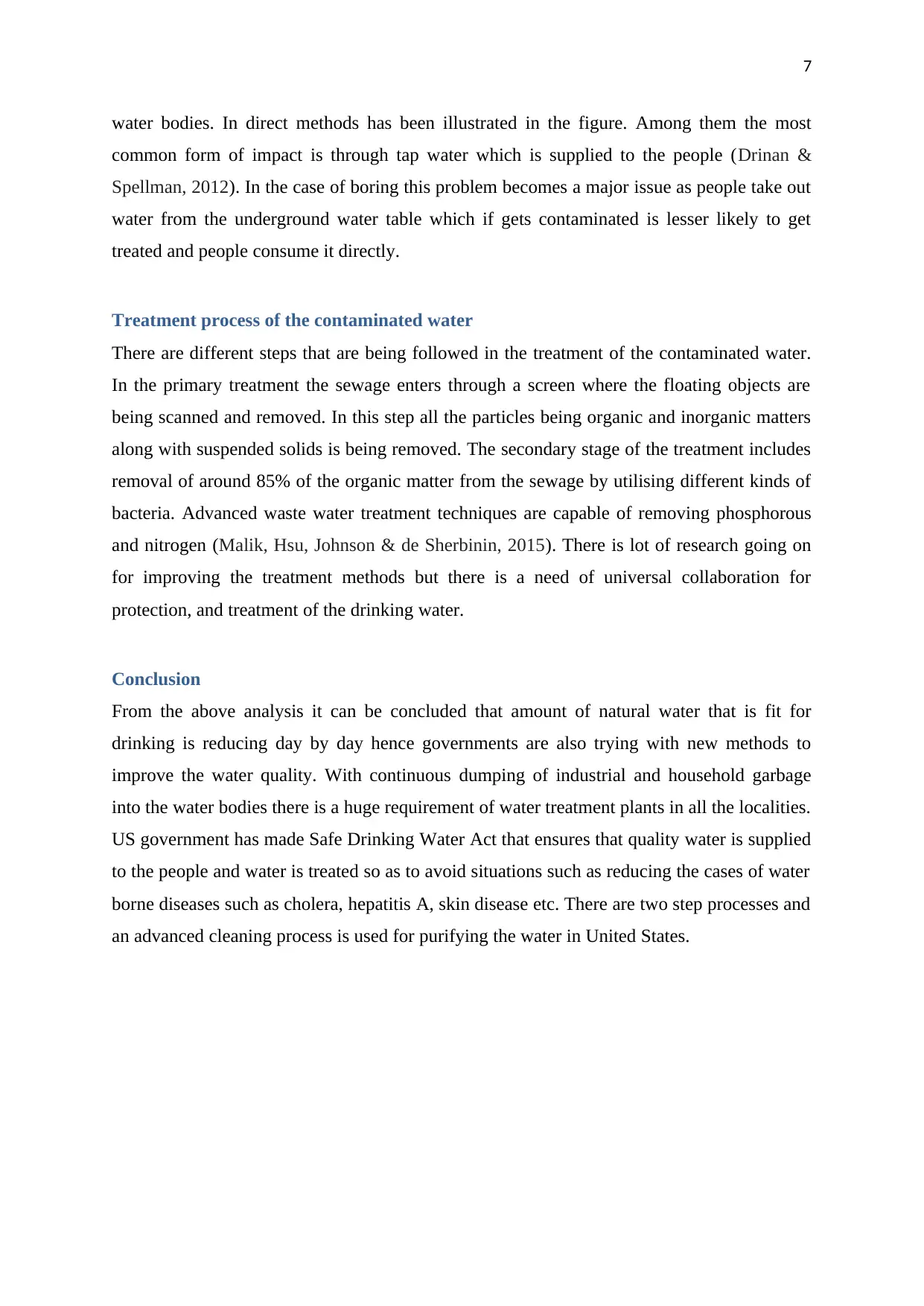
7
water bodies. In direct methods has been illustrated in the figure. Among them the most
common form of impact is through tap water which is supplied to the people (Drinan &
Spellman, 2012). In the case of boring this problem becomes a major issue as people take out
water from the underground water table which if gets contaminated is lesser likely to get
treated and people consume it directly.
Treatment process of the contaminated water
There are different steps that are being followed in the treatment of the contaminated water.
In the primary treatment the sewage enters through a screen where the floating objects are
being scanned and removed. In this step all the particles being organic and inorganic matters
along with suspended solids is being removed. The secondary stage of the treatment includes
removal of around 85% of the organic matter from the sewage by utilising different kinds of
bacteria. Advanced waste water treatment techniques are capable of removing phosphorous
and nitrogen (Malik, Hsu, Johnson & de Sherbinin, 2015). There is lot of research going on
for improving the treatment methods but there is a need of universal collaboration for
protection, and treatment of the drinking water.
Conclusion
From the above analysis it can be concluded that amount of natural water that is fit for
drinking is reducing day by day hence governments are also trying with new methods to
improve the water quality. With continuous dumping of industrial and household garbage
into the water bodies there is a huge requirement of water treatment plants in all the localities.
US government has made Safe Drinking Water Act that ensures that quality water is supplied
to the people and water is treated so as to avoid situations such as reducing the cases of water
borne diseases such as cholera, hepatitis A, skin disease etc. There are two step processes and
an advanced cleaning process is used for purifying the water in United States.
water bodies. In direct methods has been illustrated in the figure. Among them the most
common form of impact is through tap water which is supplied to the people (Drinan &
Spellman, 2012). In the case of boring this problem becomes a major issue as people take out
water from the underground water table which if gets contaminated is lesser likely to get
treated and people consume it directly.
Treatment process of the contaminated water
There are different steps that are being followed in the treatment of the contaminated water.
In the primary treatment the sewage enters through a screen where the floating objects are
being scanned and removed. In this step all the particles being organic and inorganic matters
along with suspended solids is being removed. The secondary stage of the treatment includes
removal of around 85% of the organic matter from the sewage by utilising different kinds of
bacteria. Advanced waste water treatment techniques are capable of removing phosphorous
and nitrogen (Malik, Hsu, Johnson & de Sherbinin, 2015). There is lot of research going on
for improving the treatment methods but there is a need of universal collaboration for
protection, and treatment of the drinking water.
Conclusion
From the above analysis it can be concluded that amount of natural water that is fit for
drinking is reducing day by day hence governments are also trying with new methods to
improve the water quality. With continuous dumping of industrial and household garbage
into the water bodies there is a huge requirement of water treatment plants in all the localities.
US government has made Safe Drinking Water Act that ensures that quality water is supplied
to the people and water is treated so as to avoid situations such as reducing the cases of water
borne diseases such as cholera, hepatitis A, skin disease etc. There are two step processes and
an advanced cleaning process is used for purifying the water in United States.
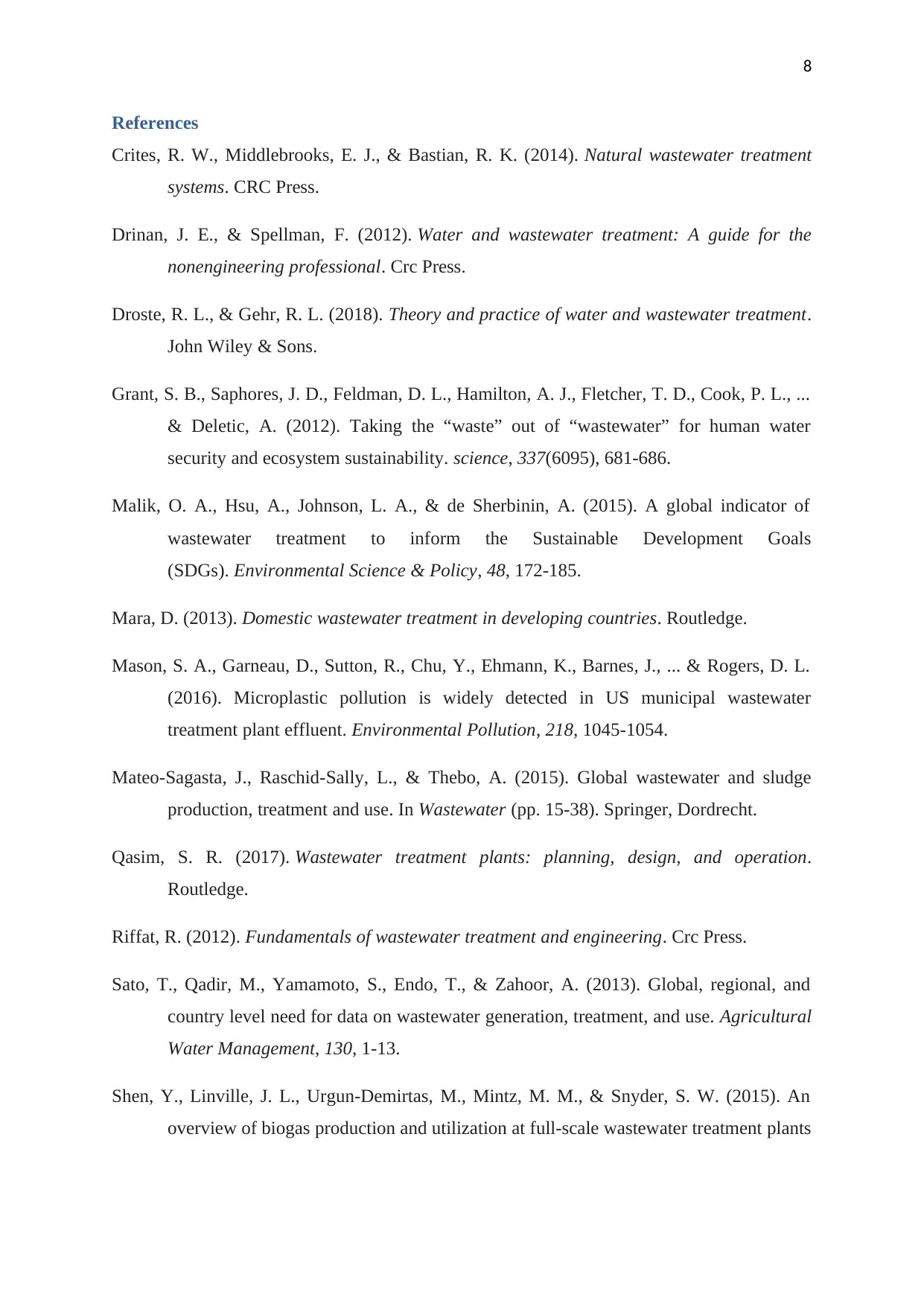
8
References
Crites, R. W., Middlebrooks, E. J., & Bastian, R. K. (2014). Natural wastewater treatment
systems. CRC Press.
Drinan, J. E., & Spellman, F. (2012). Water and wastewater treatment: A guide for the
nonengineering professional. Crc Press.
Droste, R. L., & Gehr, R. L. (2018). Theory and practice of water and wastewater treatment.
John Wiley & Sons.
Grant, S. B., Saphores, J. D., Feldman, D. L., Hamilton, A. J., Fletcher, T. D., Cook, P. L., ...
& Deletic, A. (2012). Taking the “waste” out of “wastewater” for human water
security and ecosystem sustainability. science, 337(6095), 681-686.
Malik, O. A., Hsu, A., Johnson, L. A., & de Sherbinin, A. (2015). A global indicator of
wastewater treatment to inform the Sustainable Development Goals
(SDGs). Environmental Science & Policy, 48, 172-185.
Mara, D. (2013). Domestic wastewater treatment in developing countries. Routledge.
Mason, S. A., Garneau, D., Sutton, R., Chu, Y., Ehmann, K., Barnes, J., ... & Rogers, D. L.
(2016). Microplastic pollution is widely detected in US municipal wastewater
treatment plant effluent. Environmental Pollution, 218, 1045-1054.
Mateo-Sagasta, J., Raschid-Sally, L., & Thebo, A. (2015). Global wastewater and sludge
production, treatment and use. In Wastewater (pp. 15-38). Springer, Dordrecht.
Qasim, S. R. (2017). Wastewater treatment plants: planning, design, and operation.
Routledge.
Riffat, R. (2012). Fundamentals of wastewater treatment and engineering. Crc Press.
Sato, T., Qadir, M., Yamamoto, S., Endo, T., & Zahoor, A. (2013). Global, regional, and
country level need for data on wastewater generation, treatment, and use. Agricultural
Water Management, 130, 1-13.
Shen, Y., Linville, J. L., Urgun-Demirtas, M., Mintz, M. M., & Snyder, S. W. (2015). An
overview of biogas production and utilization at full-scale wastewater treatment plants
References
Crites, R. W., Middlebrooks, E. J., & Bastian, R. K. (2014). Natural wastewater treatment
systems. CRC Press.
Drinan, J. E., & Spellman, F. (2012). Water and wastewater treatment: A guide for the
nonengineering professional. Crc Press.
Droste, R. L., & Gehr, R. L. (2018). Theory and practice of water and wastewater treatment.
John Wiley & Sons.
Grant, S. B., Saphores, J. D., Feldman, D. L., Hamilton, A. J., Fletcher, T. D., Cook, P. L., ...
& Deletic, A. (2012). Taking the “waste” out of “wastewater” for human water
security and ecosystem sustainability. science, 337(6095), 681-686.
Malik, O. A., Hsu, A., Johnson, L. A., & de Sherbinin, A. (2015). A global indicator of
wastewater treatment to inform the Sustainable Development Goals
(SDGs). Environmental Science & Policy, 48, 172-185.
Mara, D. (2013). Domestic wastewater treatment in developing countries. Routledge.
Mason, S. A., Garneau, D., Sutton, R., Chu, Y., Ehmann, K., Barnes, J., ... & Rogers, D. L.
(2016). Microplastic pollution is widely detected in US municipal wastewater
treatment plant effluent. Environmental Pollution, 218, 1045-1054.
Mateo-Sagasta, J., Raschid-Sally, L., & Thebo, A. (2015). Global wastewater and sludge
production, treatment and use. In Wastewater (pp. 15-38). Springer, Dordrecht.
Qasim, S. R. (2017). Wastewater treatment plants: planning, design, and operation.
Routledge.
Riffat, R. (2012). Fundamentals of wastewater treatment and engineering. Crc Press.
Sato, T., Qadir, M., Yamamoto, S., Endo, T., & Zahoor, A. (2013). Global, regional, and
country level need for data on wastewater generation, treatment, and use. Agricultural
Water Management, 130, 1-13.
Shen, Y., Linville, J. L., Urgun-Demirtas, M., Mintz, M. M., & Snyder, S. W. (2015). An
overview of biogas production and utilization at full-scale wastewater treatment plants
⊘ This is a preview!⊘
Do you want full access?
Subscribe today to unlock all pages.

Trusted by 1+ million students worldwide
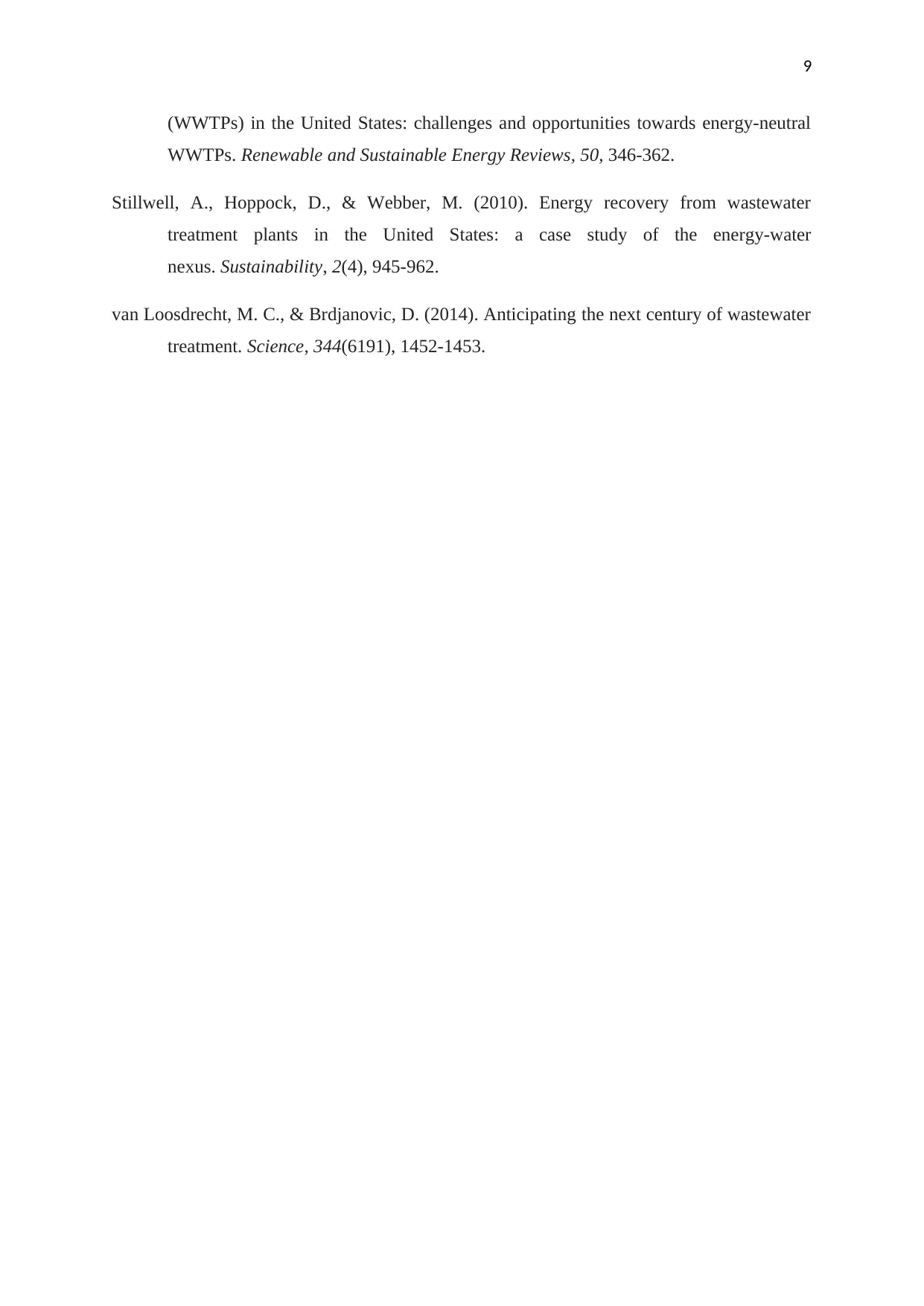
9
(WWTPs) in the United States: challenges and opportunities towards energy-neutral
WWTPs. Renewable and Sustainable Energy Reviews, 50, 346-362.
Stillwell, A., Hoppock, D., & Webber, M. (2010). Energy recovery from wastewater
treatment plants in the United States: a case study of the energy-water
nexus. Sustainability, 2(4), 945-962.
van Loosdrecht, M. C., & Brdjanovic, D. (2014). Anticipating the next century of wastewater
treatment. Science, 344(6191), 1452-1453.
(WWTPs) in the United States: challenges and opportunities towards energy-neutral
WWTPs. Renewable and Sustainable Energy Reviews, 50, 346-362.
Stillwell, A., Hoppock, D., & Webber, M. (2010). Energy recovery from wastewater
treatment plants in the United States: a case study of the energy-water
nexus. Sustainability, 2(4), 945-962.
van Loosdrecht, M. C., & Brdjanovic, D. (2014). Anticipating the next century of wastewater
treatment. Science, 344(6191), 1452-1453.
1 out of 10
Related Documents
Your All-in-One AI-Powered Toolkit for Academic Success.
+13062052269
info@desklib.com
Available 24*7 on WhatsApp / Email
![[object Object]](/_next/static/media/star-bottom.7253800d.svg)
Unlock your academic potential
Copyright © 2020–2025 A2Z Services. All Rights Reserved. Developed and managed by ZUCOL.





